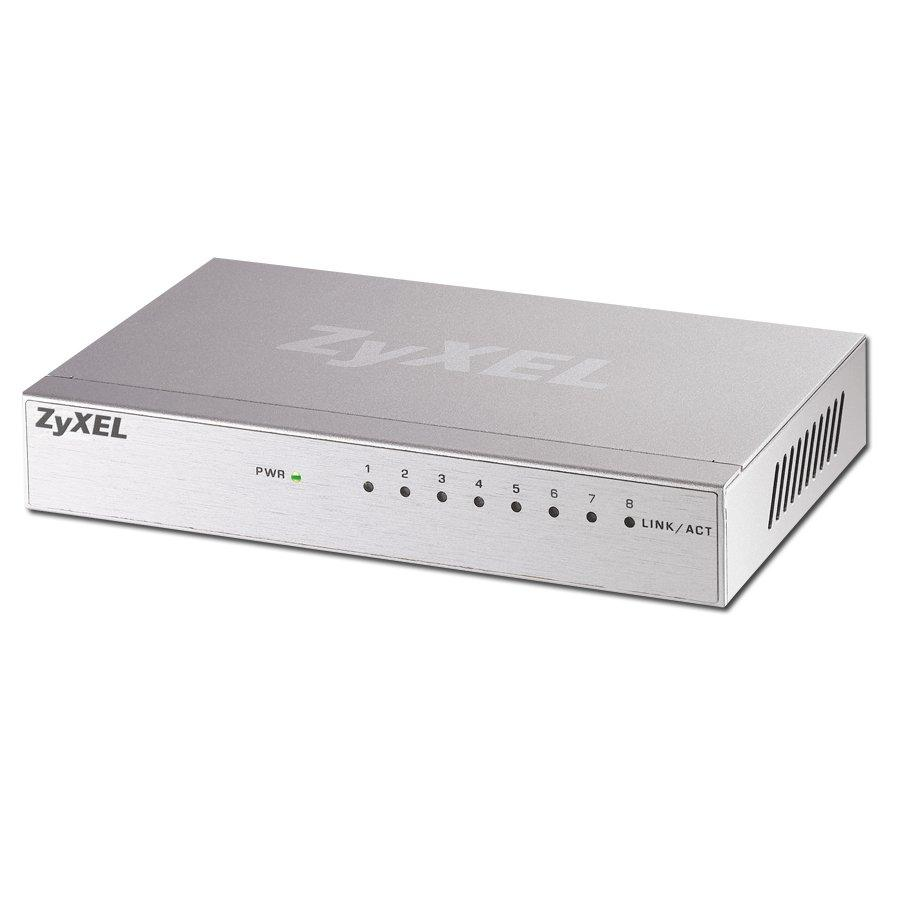Linksys SE4008 WRT 8-Port Gigabit Switch Review
We're taking a closer look at Linksys' SE4008 WRT, an eight-port GbE switch with WRT-inspired aesthetics and an oddly high price.
Why you can trust Tom's Hardware
Installation And Tear-Down
Comparison Ethernet Switches
Installation
The SE4008 WRT is fairly bulky, measuring 246 x 194 x 62 millimeters (W x D x H). This could cause issues if you're trying to install the switch on a space-constrained desk. Then again, if you're stacking the SE4008 WRT anyway, you might not even notice your networking equipment one device taller. The switch's feet have a layer of rubber, which helps the switch's stability regardless of whether a router is placed on top.
The feet play host to four slots you can use to mount the device either vertically or horizontally on the wall. You'll have to acquire the wall anchors or screws though; Linksys doesn't include them. The ports are located in the back of the switch, which could cause confusion if the LEDs are turned off and you're not able to see whether a client is plugged in.
A bundled wall wart supplies 12V/1A of power. It faces sideways, so make sure you have the room on your UPS or surge protector to plug the adapter in.
The SE4008 WRT was designed with a wing of plastic that juts away from the back of the enclosure. It covers the switch port area from above, so this minor feature is a particularly welcome addition on a desk, where liquid can be spilled and dust accumulates.
Tear-Down
The SE4008 WRT's build quality is fantastic for a device with a plastic case. The chassis is heavy-duty and adds a satisfying amount of weight to the switch. There's little to no observable flexing when pressure is applied to the body. Every piece of the switch fits together flush, and, again, the aesthetics remind us of WRT products of the past. Ventilation is more than adequate thanks to openings on the bottom and sides.
Gaining access to the internals proved difficult, necessitating a Dremel tool. If there is another way to get inside, I was not able to find it.
What holds the SE4008 WRT together, aside from a couple of screws on the bottom, are sets of unreachable tabs that are tough to disengage. Given the difficulty in opening its case, the SE4008 WRT may be cheap enough that warranty repair work is out of the question. A direct replacement is more likely if your unit fails during its first year. Once the main pieces are clipped together at the factory, the plastic shell looks like it's never meant to be opened again.
Get Tom's Hardware's best news and in-depth reviews, straight to your inbox.
With a heat sink affixed to the Realtek RTL8370 controller, thermal issues shouldn't be a concern. The sink appeared to do its job adequately during use, as the case only became slightly warm to the touch.
Current page: Installation And Tear-Down
Prev Page Specifications And Features Next Page Test Results And Conclusion-
falchard I always liked how you can stack the old Linksys network products. Stacked the cable modem and Wireless. The problem with it was heat. Mine got really hot. The other problem is these are now Belkin products, not Cisco. Personally, I can't see myself getting cheap Belkin products.Reply -
Kewlx25 0.3ms is way too high. The tester must not be able to test as low as switches go. My min ping to my firewall is 0.008ms.Reply
And how good is the tester for bandwidth saturation? The benchmark shows about 930Mb/s on the bi-directional test. I get 970Mb/s bi-directional through my firewall with NAT. -
I've had a lot of Linksys old modems, voip, etc, and it was super cool that you would stack them one on the other, and looked great.Reply
These don't look as good, and the "not a cisco" is a big deal to me. Cisco was the primary reason I bought Linksys in the past. I just buy tp-link these days. Asus is too expensive, but another option. The other brands are mostly junk. -
nocona_xeon (article quote): "The SE4008 WRT's specifications include a 128KB memory buffer, an 8000-entry MAC address table, an MTBF of approximately 853,300 hours and status LEDs for connectivity/activity (there's a switch on the back to turn them off). The unit utilizes the typical store-and-forward method of passing data along."Reply
Linksys (during its "from Cisco transition") completely failed to provide an updated firmware that made a specific and rather popular product secure, which was now theirs (an "inherited" product so I guess they didn't care as much).
So, I dumped them. Likely over two, three years ago now.
I would rather pay the price premium for business quality devices rather than tolerate dropped LAN connections, "help desk" people who are told to say "That firmware update will be available soon" (which is no fault of their own - they're told to say that - but it always seems to happen when a new Linksys product is about to come out - ie Linksys abandons the older product after making promises).
And the longevity of 853,300 hours means what when older products are abandoned? -
Kewlx25 For $65 you can get an 8 port HP Procurve 8port gig switch with 1.2us latency, 12 watt maximum theoretical power(same), and a life time warranty.Reply -
firefoxx04 my unmanaged TP link 8 port does the job well and is much smaller. It easily allows me to run 100-120MB/s transfer speeds between several systems. Great addition to my Tomato N16. Best part is that it was $20 with prime shipping...Reply
Managed would be nice for business but in the home do you really need it? My router already controls the network and I dont need Vlans. I guess for a lab I might want that.







